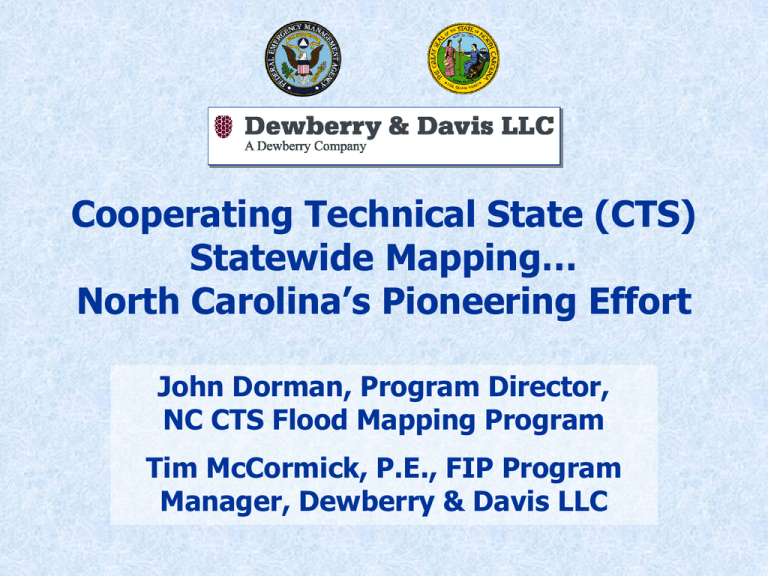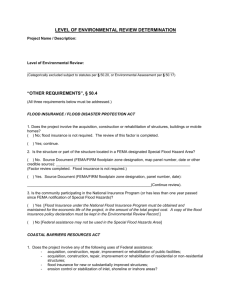Cooperating Technical State (CTS) Statewide Mapping… North
advertisement

Cooperating Technical State (CTS) Statewide Mapping… North Carolina’s Pioneering Effort John Dorman, Program Director, NC CTS Flood Mapping Program Tim McCormick, P.E., FIP Program Manager, Dewberry & Davis LLC Background NOTE - Six storms (Bertha, HURRRICANE IRENE Oct 16 -17 HURRRICAN FLOYD HURRRICANE DENNIS Sept 15 - 16 Aug 30 - Sept 4 Fran, Bonnie, Dennis, Floyd & Irene) have impacted or made land fall on the North Carolina coast in the last five years Why North Carolina Undertook This Project State’s vulnerability to hurricanes and flooding 14 federally declared disasters since 1989 Hurricane Floyd damages = $3.5 billion 4,117 uninsured/under-insured homes destroyed as result of Hurricane Floyd Why North Carolina Undertook This Project (Continued) Hurricane Floyd revealed flood hazard data and map limitations Age of State’s FIRMs 55% at least 10 years old 75% at least 5 years old FEMA’s mapping budget is finite State receives only one updated flood study per county per year Many counties and communities lack resources to take on this responsibility Accurate, up-to-date flood hazard data information crucial to protect lives and property State Strategies and Implementation North Carolina’s Strategies Establishment of Unprecedented Statewide floodplain mapping program Designated Cooperating Technical State by FEMA Partnership with (FEMA) and 16 other Federal Agencies Develop program to collect accurate elevation data and develop flood data to produce FIRMs Program Deliverables High-resolution topographic data and accurate DEMs Engineering basin studies Base map data Countywide digital FIRMs State-of-the-art, dynamic IT infrastructure Real-time flood forecasting and inundation mapping capability Other Program Deliverables Findings and analysis of LIDAR capabilities Recommend standard for LIDAR accuracy Implementing NSDI approach Tailoring and implementing new FEMA scoping procedures Testing telescoped post-preliminary procedures Implementing new DFIRM standard Developing Policy & Procedures Manual Developing Higher Standards Guidebook for community officials Direct Benefits from Program USGS estimates b/c ratio of 3.5:1 Current, accurate data for sound siting and design decisions Use of updated data for floodplain management will reduce long-term flood losses Updated data will alert at-risk property owners of the need for flood insurance Faster, cheaper FIRM updates More equitable flood insurance ratings through NFIP Other Benefits of Program Digital format allows for more efficient, precise flood risk determinations Digital format will provide more timely updates for floodplain management Digital format allows for use with GIS for analysis and planning Digital Information System allows for online access 24 hours a day DEMs will be useful for almost any engineering or planning applications Program Approach/ Implementation Develop Statewide: Basin Plans through scoping process Digital Elevation Models (DEMs) Updated base maps (DOQs or better local base) Updated flood data Countywide DFIRMs Digital distribution through State’s IT Hard copy through FEMA’s MSC State/local relationship for data sharing Program Approach/ Implementation (Continued) Phase I—Eastern 6 Basins initiated this year Preliminary FIRMs for White Oak, Tar-Pamlico, and Lumber by Sept. 2001 Preliminary FIRMs for Neuse, Cape Fear, and Pasquotank counties by Sept. 2002 Phase II—5 Basins initiated in FY 01-02 Chowan, Roanoke, Yadkin, New, Catawba Phase III—Final 6 Basins initiated in FY 02-03 Broad, Watauga, French Broad, Little Tennessee, Savannah, Hiwassee North Carolina River Basins—by Phase Phase I—blue Phase II—gold Phase III—green Program Approach/ Implementation (Continued) Design, develop, and implement dynamic IT infrastructure to analyze, maintain, archive, and disseminate flood maps and associated data for North Carolina Flood Mapping Program Present and distribute mapping data, associated reports, and other Framework data layers to public via Internet Final system design will be completed by June 2001 Operable system will be implemented by September 30, 2001 Program Approach/ Implementation (Continued) Contracting approach for procuring engineering and mapping services Qualifications-based selection Greenhorne & O’Mara Team Watershed Concepts Team Development of Mapping Activity Statements Development of process to vet, resolve, and document program issues and establish policies Established Program website for public ncfloodmaps.com Program Approach Negotiating product specifications that meet State, FEMA, and client needs Project management tools, such as: GIS-based Scoping database MS Project model Collaborative Web site Developing Policy & Procedures Manual Developing Higher Standards Guidebook for community officials Program Funding In August 2000, North Carolina General Assembly allocated funding for first six river basins ($23 million) Additional State funding from Partners ($2.75 million) FEMA has contributed $6 million, as well as in-kind professional services North Carolina is also working with other Federal partners to secure additional funding North Carolina CTS Flood Mapping Program OSBPM NC Center for Geographic Information and Analysis NC Geodetic Survey NC Division of Emergency Management Federal Emergency Management Agency John Dorman, Program Director/Chair Project Manager Mapping Coordination Contractor Dewberry & Davis LLC CTS Committee Program Manager State Floodplain Mapping Contractor Greenhorne & O’Mara, Inc. State Floodplain Mapping Contractor Watershed Concepts, Inc. Program Schedule By end of State FY 2005 = Produce DEMs, updated flood data, and digital FIRMs for remaining 11 river basins Enter “maintenance” phase in FY 2002 - 2003 for first 3 river basins Agreements/Tasking Process Agreements versus Delivery Orders Agreements: Negotiated and signed by CTS Partners Include overall MOA, funding agreements, and Mapping Activity Statements Delivery Orders (DOs): State contracting with private A/E firm(s) DOs are mechanisms to complete work agreed to by CTS Partners under the Mapping Activity Statements Hierarchy of Agreements Memorandum of Agreement Funding Agreement No. 1 Mapping Activity Statement A MAS B Funding Agreement No. X MAS C MAS D MAS E MAS F MAS MAS MAS Memorandum of Agreement Establishes formal overall partnership between State and Federal and local Partners State, FEMA, and other Federal Partners will collaborate on flood hazard identification and post flood disaster hazard verification activities Establishes CTS Committee Signed by State and all Partners (9/15/00) Funding Agreements Written under “umbrella” of overall Memorandum of Agreement Summarizes available funding sources and amounts for specific mapping activities Ties funding to specific Mapping Activity Statements Signed by all partners contributing funding to the relevant activities Mapping Activity Statement State and Partners developing Mapping Activity Statements for specific activities References overarching Funding Agreement Signed by State and all Partners contributing products, services, funding, and/or technical support to the activity Mapping Activity Statement (Continued) Also Specifies: Scope FEMA Technical Period of Performance Standards Schedule Products Certification requirements Assistance and Resources QA/QC Process Subcontractors Reporting Point of Contact Mapping Activity Statements Currently Being Developed A Project Scoping for Six Eastern River Basins* B Information Management System C Digital Base Map for Six Eastern River Basins* D Digital Elevation Data Development for Six Eastern River Basins* E Updated Flood Hazard Data and Digital FIRM Production for Six Eastern River Basins* *Future Mapping Activity Statements will be developed for the remaining Basins in the State Mapping Activity Statements Currently Being Developed (Continued) F Technology and Data Standards G Real-Time Flood Forecasting and Inundation Mapping H Inter-Agency Coordination ** Post-Flood Hazard Verification (Template) **Will be used to execute separate MASs for specific flooding disasters Project Components Scoping Map Production Community Review Scoping Research/inventory all available elevation, flood hazard, and digital base map data Assess existing flood hazard data on effective FIRMs Determine appropriate technical method for developing up-to-date flood hazard data and establishing priority level Scoping (Continued) Conduct outreach activities to determine needs for updated FIRMs Identify data that need to be developed or acquired Determine proposed scales, paneling scheme, and format for digital FIRM production Map Production Updated engineering analyses and floodplain mapping State has contracted with privatesector firm(s) to conduct this work Work will include: Conducting flood hazard analyses and producing updated digital FIRMs Designing and implementing the IT Infrastructure Community Review Preliminary countywide digital FIRMs issued to each county and its communities for review and comment County meetings to present maps and provide opportunity for comment Statutory 90-day appeal period CTS Committee Overview Purpose and Role of CTS Committee Strategic planning for program direction and associated activities Provide input and feedback regarding policies, data, and products Facilitate multi-level government coordination Provide technical and programmatic expertise and advice Review and concur on Mapping Activity Statement Agreements CTS Committee Member Organizations Federal Agencies: FEMA USGS NASA USACE EPA NOAA HUD NOAA NWS SBA EDA DOT USDA CTS Committee Member Organizations (Continued) State Agencies: OSBPM NCDEM NCGS CGIA Land Records Management Div. DENR NCDOT NC Office of Information Technology Dept. of Insurance CTS Committee Member Organizations (Continued) Other State Organizations: General Assembly GICC/Statewide Mapping Advisory Committee League of Municipalities Association of County Commissioners North Carolina State University CTS Committee Member Organizations (Continued) Local Government Agencies: Greensboro Asheville Lenoir County Wake County New Hanover County Charlotte/Mecklenberg County CTS Committee Member Organizations (Continued) Technical Advisors: NC Floodplain Managers Association Professional Engineers of NC NC Society of Surveyors ASPRS, NC Chapter URISA, NC Chapter NC Citizens for Business and Industry FGDC Open GIS Consortium Structure of CTS Committee Chaired by John Dorman, OSBPM Executive Committee Day-to-day oversight of program Membership includes CGIA, NCGS, NCDEM, and FEMA Will refer items to the overall CTS Committee CTS Committee Technical Working Groups Higher Standards Real-time Flood Forecasting Post-Flood Verification Meet on monthly basis in Raleigh Cooperating Technical State (CTS) Statewide Mapping… North Carolina’s Pioneering Effort QUESTIONS ? ? ? ? ?







